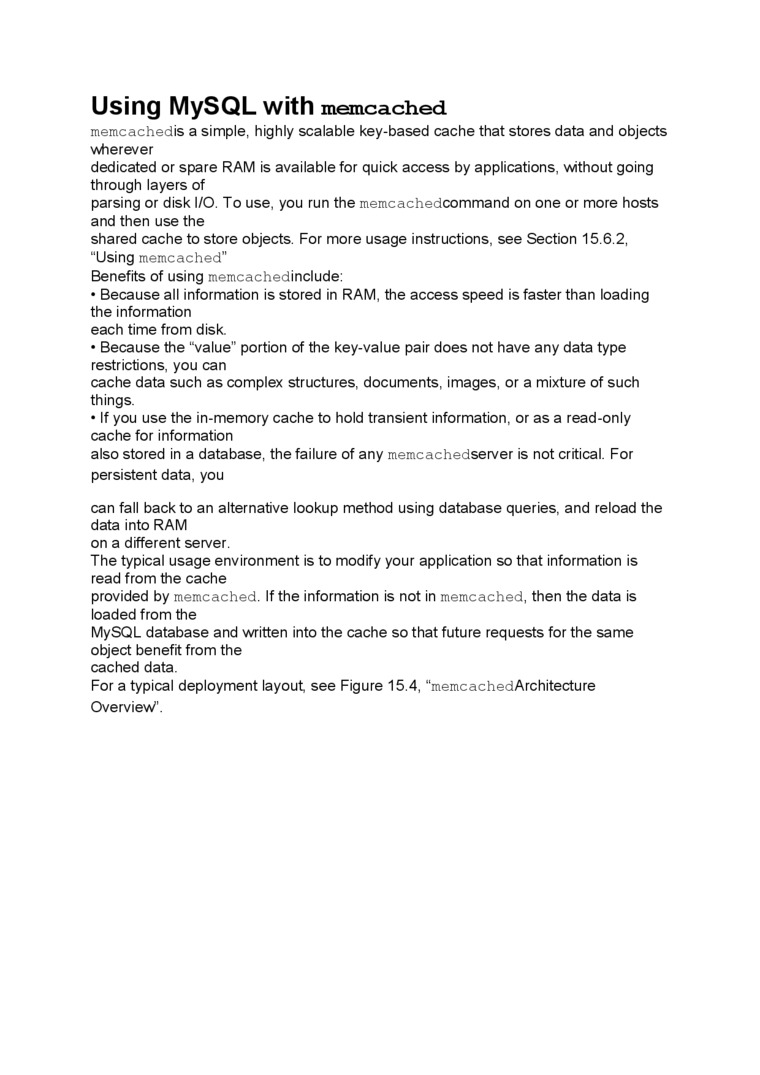89579

Using MySQL with memcached
memcachedis a simple, highly scalable key-based cache that Stores data and objects wherever
dedicated or spare RAM is available for quick access by applications, without going through layers of
parsing or disk l/O. To use, you run the memcachedcommand on one or morę hosts and then use the
shared cache to storę objects. For morę usage instructions, see Section 15.6.2, “Using memcached”
Benefits of using memcachedinclude:
• Because all information is stored in RAM, the access speed is faster than loading the information
each time from disk.
• Because the “value" portion of the key-value pair does not have any data type restrictions, you can
cache data such as complex structures, documents, images, or a mixture of such things.
• If you use the in-memory cache to hołd transient information, or as a read-only cache for information
also stored in a database, the failure of any memcachedserver is not critical. For persistent data, you
can fali back to an alternative lookup method using database queries, and reload the data into RAM on a different server.
The typical usage environment is to modify your application so that information is read from the cache
provided by memcached. If the information is not in memcached, then the data is loaded from the
MySQL database and written into the cache so that futurę requests for the same object benefit from the cached data.
For a typical deployment layout see Figurę 15.4, “memcachedArchitecture OvervieW\
Wyszukiwarka
Podobne podstrony:
AND SIMPLE S EG ME NT ATI ON THAT IS CLEAR AND EASY TO UNDERSTAND style hołd sculpt hołd XXL
Using MySQL and memcached with Ruby There are a number of different modules for interfacing to memca
Using the InnoDB memcached Plugin with Replication Because the InnoDB memcached daemon plugin suppor
Tuning Performance of the InnoDB memcached Plugin Because using InnoDB in combination with memcached
Using MySQL and memcachedwith Python The Python memcachemodule interfaces to memcachedservers, and i
SQL nodes. If you compile MySQL with clustering support, and perform the default installation (using
Using GTlDs for Failover and Scaleout There are a number of techniques when using MySQL Replication
UpBeat3 Test A{ TEST 7BStudent A1 Write sentences with the past simple passive. 0
UpBeat3 Test B{ TEST 7B 1Student BWrite sentences with the past simple passive. O The film/make/Chin
How MySQL Deals with Constraints MySQL enables you to work both with transactional tables that permi
Security Guidelines Anyone using MySQL on a Computer connected to the Internet should read this sect
Using Foreign Keys In MySQL, innoDB tables support checking of foreign key constraints. See Section
Creating a User for Replication Each slave must connect to the master using a MySQL user name and pa
Getting memcached Statistics The memcached system has a built-in statistics system that collects inf
Overview of MySQL with Windows Failover Clustering Microsoft Windows is consistently ranked as the t
Transactions and the count () function. When using MySQL Cluster Replication, it is not possible to
Using MySQL Proxy There are a number of different ways to use MySQL Proxy. At the most basie level,
Using MySQL within an Amazon EC2 Instance The Amazon Elastic Compute Cloud (EC2) service provides vi
Using Replication with Different Master and Slave Storage Engines It does not matter for the replica
więcej podobnych podstron